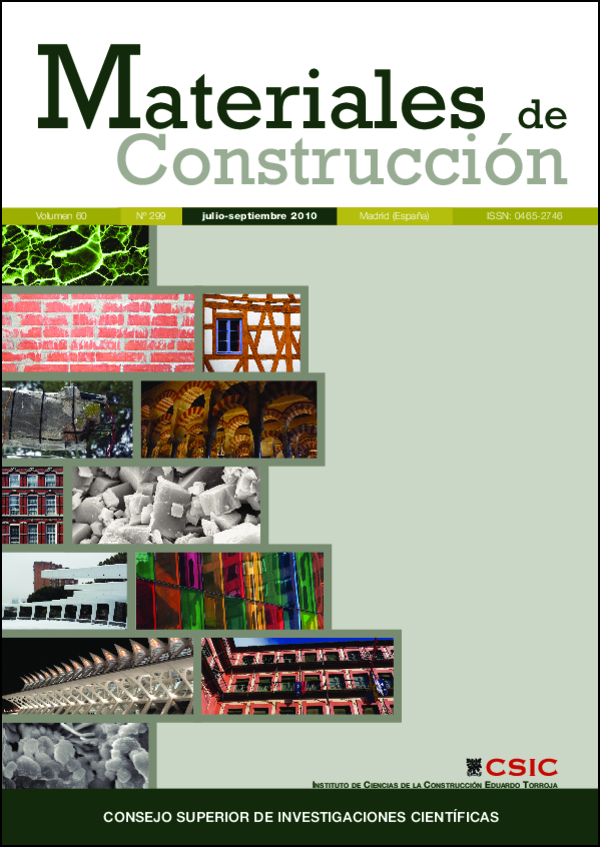New absorbent material acoustic based on kenaf’s fibre
DOI:
https://doi.org/10.3989/mc.2010.50809Keywords:
sound absorption, acoustic impedance, airflow resistivity, natural fibreAbstract
Acoustic Standards in the building are responsible for, companies and individuals, propose new acoustic materials for the sound isolation. This paper presents a new sound-absorbent material, it is based on natural fibres, particularly fibres of kenaf. It also proposes an empirical model for this material, this models depends on the frequency. There are accepted models from the scientific community about mineral wool, glass wool, rock wool, foam or polyester fibre. Several of these models are empirical. They are obtained from the equation adjustments about the acoustic impedance and propagation constant behaviour, depending upon the flow resistivity, fibre’s diameter and density. There are even standards like UNE-EN 12354-6 where these models are accepted under certain limitations like the fundamental basis as in the materials’ acoustics behaviour prediction. From the various tests conducted in the laboratory, empirical equations are proposed for this new acoustic material. In addition, there has been a first approach to validate this model in combination with a micro-structural model, based on the steps taken by Bies-Hansen (1), which allows us to obtain the value of the resistance to flow.
Downloads
References
(1) Bies, D. A.; Hansen, C. H: “Flow resistance information for acoustical desing”. Applied Acoustics (1980), vol. 13, pp. 357-391. doi:10.1016/0003-682X(80)90002-X
(2) http://www.fao.org/index_es.htm
(3) Delany, M. E.; Bazley, E. N.: “Acoustical Properties of Fibrous Absorbent Materials”. Applied Acoustics, nº 3 (1970), pp. 105-116. doi:10.1016/0003-682X(70)90031-9
(4) Miki, Y.: “Acoustical Properties of Porous Materials-Modifications of Delany-Bazley Models“. Journal of the Acoustical Society Jpn (E), nº 11, 1 (1990) pp. 19-24.
(5) Miki, Y.: “Acoustical Properties of Porous Materials-Generalitations of empirical models”. Journal of the Acoustical Society Jpn (E), nº 11, 1 (1990) pp. 13-24.
(6) Dunn, I. P.; Davern, W. A.: “Calculation of acoustic impedance of multi-layer absorbers”. Applied Acoustics, nº 19 (1986), pp. 321-334. doi:10.1016/0003-682X(86)90044-7
(7) Garai, M.; Pompoli, F.: “A simple empirical model of polyester fibre materials for acoustical applications”. Applied Acoustics, nº66 (2005), pp. 1383-1398. doi:10.1016/j.apacoust.2005.04.008
(8) Wang, X. et al.: “Regression analysis of acoustical properties of polyurethane foams”. Journal of Sound and Vibration, nº 273 (2004), pp. 1109-1117. doi:10.1016/j.jsv.2003.09.039
(9) Shoshani, Y.; Yakubov, Y.: “Numerical assessment of maximal absorption coefficients for nonwoven fiberwebs”. Applied Acoustics, nº 59 (2000), pp. 77-87. doi:10.1016/S0003-682X(99)00015-8
(10) Voronina, N.: “Improved Empirical Model of Sound Propagation Through a Fibrous Material”. Applied Acoustics, vol. 48, nº 2 (1996), pp. 121-132. doi:10.1016/0003-682X(95)00055-E
(11) Voronina, N.: “An Empirical Model for Elastic Porous Materials”. Applied Acoustics, vol. 55, nº 1 (1998), pp. 67-83. doi:10.1016/S0003-682X(97)00098-4
(12) Voronina, N.: “An empirical model for rigid-frame porous materials with low porosity”. Applied Acoustics, nº 58 (1999) pp. 295-304. doi:10.1016/S0003-682X(98)00076-0
(13) Voronina, N.; Horoshenkov, K. V.: “A new empirical model for the acoustic properties of loose granular media”. Applied Acoustics, nº 64 (2003), pp. 415-432. doi:10.1016/S0003-682X(02)00105-6
(14) UNE-EN 12354-6:2004: Acústica en la edificación. Estimación de las características de las edificaciones a partir de las características de sus elementos, parte 6, Absorción sonora en espacios cerrados.
(15) Del Rey, R.; Alba, J.; Sanchís, V.: “Proposal a empirical model for absorbent acoustical materials based in kenaf”. 19th International Congress on Acoustics. Madrid, 2-7 septiembre de 2007.
(16) UNE-EN ISO 10534-2: Acústica: “Determinación del coeficiente de absorción acústica y de la impedancia acústica en tubos de impedancia”, parte 2, “Método de la función de transferencia” (ISO 10534-2:1998).
(17) Navacerrada, M. A.; Díaz, C.; Pedrero, A.; García, L. E.: “Absorción acústica de espumas de aluminio”. Mater. Construcc., vol. 58, nº 291 (2008).
(18) Ingard, K. U.; Dear, T. A.: “Measurement of Acoustic Flow Resistance”. Journal of sound and Vibration,nº 103 (1985), pp. 567-572. doi:10.1016/S0022-460X(85)80024-9
(19) UNE-EN 29053:1994. Acústica. Materiales para aplicaciones acústicas. Determinación de la resistencia al flujo de aire. (ISO9053:1991).
Downloads
Published
How to Cite
Issue
Section
License
Copyright (c) 2010 Consejo Superior de Investigaciones Científicas (CSIC)

This work is licensed under a Creative Commons Attribution 4.0 International License.
© CSIC. Manuscripts published in both the print and online versions of this journal are the property of the Consejo Superior de Investigaciones Científicas, and quoting this source is a requirement for any partial or full reproduction.
All contents of this electronic edition, except where otherwise noted, are distributed under a Creative Commons Attribution 4.0 International (CC BY 4.0) licence. You may read the basic information and the legal text of the licence. The indication of the CC BY 4.0 licence must be expressly stated in this way when necessary.
Self-archiving in repositories, personal webpages or similar, of any version other than the final version of the work produced by the publisher, is not allowed.
















